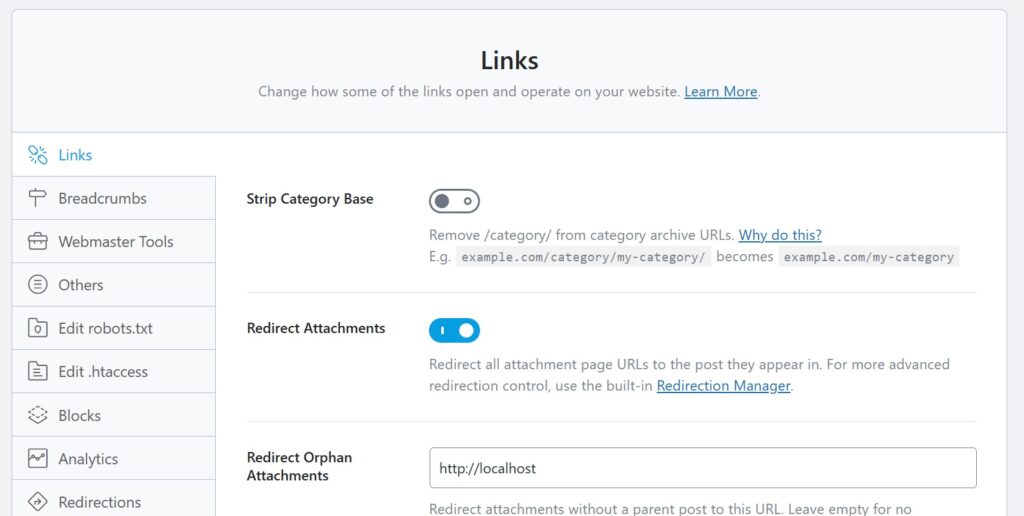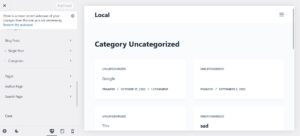These pages are a part of every WP site – search, author, archives, tag, categories, post, etc. Although all pages on a website are important, not all of them should be in the index of search engines. What is the reason for the same? Archives display the content of the post. For example, if you enter a phrase or word in the search box and click the submit button, WP will show the list of posts containing the word you entered in the search box. In other words, the six pages I have mentioned above have duplicate content.
Although you can edit the page and add the “meta robots noindex” tag to it, there are easier ways of doing this. For example, you can install a search engine optimization plugin and configure it. Which extension must you use? Rank Math and Yoast are currently the best SEO plugins. Here’s a comparison of the two extensions.
Yoast vs Rank Math
User interface

Yoast’s user interface looked decent in the past. It wasn’t very attractive. In 2023, it got a makeover. The settings UI looks fresh, and beautiful, and is much easier to use. It boasts a search box that lets you quickly navigate to a specific option. For example, if you want to configure the site title setting, enter the phrase “title” in this box.

Rank Math’s user interface hasn’t changed much since it was launched. Many settings of the two SEO extensions are pre-configured. However, you will have to go through them to make sure pages such as tag, category, archive, and search pages are not indexed by search engines.
Modular approach
Rank Math is a modular plugin i.e. its entire code will reside on the server but you have the freedom to disable features you won’t use. Is there any benefit of turning off a feature? The settings interface will have fewer options if you deactivate any of the functions of RM.
As soon as you activate Yoast, every feature of this WordPress extension will be active. You can ignore the functions you don’t wish to use. There’s a toggle option on the plugin’s settings page to disable the following features:
- Readability analysis, insights, inclusive language analysis.
- Text link counter, cornerstone content.
Schema integration
The schema module has been a part of Yoast for a long time. It hasn’t got any significant changes to be honest. When you open the post editor, you will find the schema settings for the post right below the editor in the Yoast panel. In the panel, there are two drop-boxes – one to choose the page type and another to select the article type.
Yoast supports these page schema types – web, item, about, FAQ, QA, profile, checkout, search results, real estate, contact, and medical. The Article type it supports are as follows:
- None, tech, scholarly.
- Advertiser content, news, social media posting.
- Blog post.
Like Yoast, RM’s schema module is available to the user editing the post. To access it, click the Rank Math post SEO score and click on the certificate icon. Now, choose the schema you want to use and click the blue button. RM will open a popup containing several text fields. You must fill out these fields to ensure that the schema is error-free. If you don’t fill in some fields, the Google Rich Results testing tool (or similar tools) will display an error.
RM free version supports these schemas:
- Article, course, event, restaurant, software, recipe, video.
- Job posting, music, podcast, person, product.
Setup Wizard
Configuring Rank Math is easier compared to Yoast, thanks to the plugin’s intuitive setup wizard. The four steps of the wizard are as follows:
- Import, your site, and analytics.
- Sitemaps, optimization, ready.
Most of the settings of Yoast are pre-configured. There’s a first-time configuration option in the plugin which will guide you in making your website SEO friendly.
Tracking keyword rankings
This feature is available in RM and unavailable in its counterparts. To use it, you must connect your site with your Rank Math account. If you do so, you can not only track the position of keywords in search result pages, but also verify your site with GSC, auto-submit sitemaps to Google, use the RM SEO analyzer module to find errors on your website, and more.
Redirections
Rank Math was one of the first free SEO extensions to have the URL redirection feature built-in. There’s a dedicated page for the same. On the “Redirections” page, you’ll find a button “Add New”. You should click this button. This free feature of RM is a part of the Yoast Premium edition.
Internal links
The two WordPress search engine optimization plugins suggest links when you’re working on an article. You can embed these URLs in your post to improve the internal linking structure of the website.
Readability analysis
Rank Math doesn’t analyze and grade your content nor does it show excessive passive voice usage but its counterpart does.
Yoast and Rank Math plugins have the following features:
- Sitemap generator.
- Breadcrumb system.
- Webmaster settings.
- Htaccess file editor.
- Robots.txt editor.
- Table of contents block.

